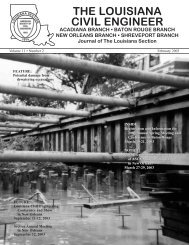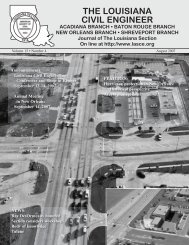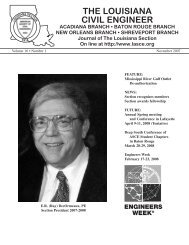THE LOUISIANA CIVIL ENGINEER - lasce
THE LOUISIANA CIVIL ENGINEER - lasce
THE LOUISIANA CIVIL ENGINEER - lasce
Create successful ePaper yourself
Turn your PDF publications into a flip-book with our unique Google optimized e-Paper software.
Case for natural channel design in Louisiana<br />
By Lee W. Forbes, PE<br />
The concept of natural channel design<br />
(NCD) only recently has been introduced to the<br />
water resources engineering community in<br />
Louisiana. Understandably, our water resource<br />
infrastructure improvement efforts have been<br />
focused on immediate needs such as coastal wetland<br />
restoration, drainage, and flood control.<br />
There has been little opportunity to examine<br />
more closely the effectiveness and the long-term<br />
sustainability of Louisiana’s extensive and intricate<br />
network of natural and improved conveyance<br />
channels. They are a seemingly boundless<br />
collection of<br />
• rivers<br />
• bayous<br />
• passes<br />
• creeks<br />
• cuts<br />
• canals<br />
• coulees<br />
• swales<br />
• ditches and<br />
• stormsewers<br />
that handle and convey the vast amounts of surface<br />
waters with which Louisiana is both blessed<br />
and cursed.<br />
Traditional flood control and drainage<br />
improvement design processes in Louisiana have<br />
focused on maximized conveyance to relatively<br />
unconfined outfalls such as the lakes and larger<br />
rivers, or to constructed regional detention areas<br />
and basins. These designs are rooted in attempts<br />
to employ channel configurations of the simplest<br />
geometric forms. This reasonably ensures that<br />
the flows through the resulting structures during<br />
larger storm events can be predicted accurately<br />
and thereby most effectively minimize the potential<br />
for flooding. However, such channel designs<br />
fail to recognize and manage the intrinsic variability<br />
associated with storm flows that — as a<br />
result — cannot be accommodated adequately<br />
by the resulting engineered structures. It will be<br />
attempted herein to demonstrate that it is incumbent<br />
on the engineer responsible for water<br />
resource design to understand and embrace a<br />
new paradigm — natural channel design. This<br />
is especially true here in Louisiana with our<br />
extensive and intricate network of conveyance<br />
channels.<br />
Natural channel design<br />
Natural channel design is an attempt to provide<br />
water resource improvements in — and<br />
restore impaired streams as shown in Figure 1 to<br />
— a state of natural channel stability or dynamic<br />
equilibrium. This is done through the understanding<br />
of fluvial morphology and its application<br />
via hydraulic design methodologies. Fluvial<br />
geomorphology is the science of the formation of<br />
riverbed, flood plain, and stream forms by the<br />
action of water. Though it has only become recognized<br />
in the United States in the last 10 years,<br />
this science is a vital component of water<br />
resources management and it is long established,<br />
well developed and documented through the<br />
extensive studies and writings of Luna B.<br />
Leopold, M. Gordon Wolman, E.W. Lane, David<br />
L. Rosgen, Richard Hey, and other hydrologists<br />
and fluvial geomorphologists.<br />
The schematic balance shown in Figure 2,<br />
developed by E.W. Lane (after Lane, 1955), presents<br />
an analogous, qualitative model of the predominant<br />
factors affecting stream equilibrium<br />
and the natural response of a channel to alterations<br />
in these factors in the form of degradation<br />
and aggradation. River systems express an<br />
inherent and entropic tendency toward minimum<br />
total work and uniform work rate in response to<br />
the natural variations of water and sediment<br />
loads that enter the system.<br />
Natural channel stability is characterized by<br />
the ability of a stream — over time and in its<br />
present climate — to transport the natural variation<br />
of water and sediment loads produced by<br />
its watershed in a manner that it maintains its<br />
Figure 1. Post-construction scene of a typical stream restoration project.<br />
(Image courtesy of Fuller, Mossbarger, Scott, May Engineers.)<br />
Figure 2. Lanes relationship of stream stability and the factors that<br />
affect degradation and aggradation (After Rosgen, 1996).<br />
Lee W. Forbes, PE, earned his BS degree in petroleum engineering from LSU in 1985 and his MS degree in civil engineering from LSU in 1988 with<br />
emphasis in environmental engineering. Forbes is a licensed engineer in Louisiana, Texas, Arkansas, North Carolina, and Michigan. Currently employed<br />
as a Senior Engineer with Geomatrix Consultants in Houston, Texas, he has over 15 years’ experience in private practice with emphasis on environmental<br />
assessment and remedial design. In the mid-1990s, Forbes shifted his focus to natural channel design and sustainable watershed management with<br />
his work on several landmark projects in Michigan, full-delivery stream restoration projects in North Carolina and the development of natural channel<br />
design methodologies for the Gulf Coast region in Louisiana and Texas. He currently serves on the national ASCE Technical Committee for Urban Stream<br />
Restoration where he endeavors to integrate the disciplines of natural channel design into conventional engineering practice to improve and sustain water<br />
resources.<br />
<strong>THE</strong> <strong>LOUISIANA</strong> <strong>CIVIL</strong> <strong>ENGINEER</strong> / MAY 2006 5






